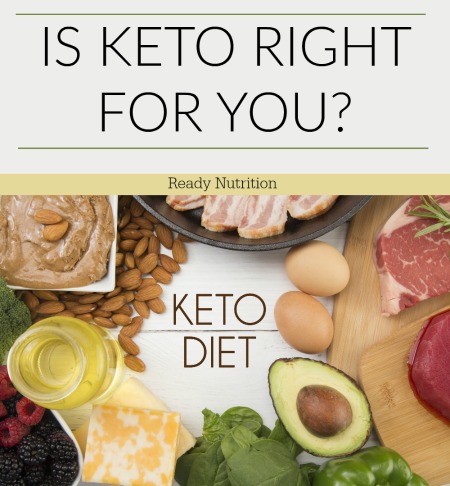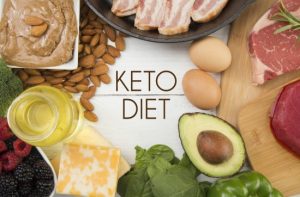Everywhere you look you see articles and videos about the benefits and the downsides of the ketogenic diet. We wrote about the keto diet years ago [1], but because there’s so much information out there, we want to share more insight with you because it’s important to understand what it is and if it’ll work for you before jumping in with both feet.
What Is The Keto Diet Anyway?
The ketogenic diet is one that is extremely low in carbohydrates and high in fats. When you reduce your carbohydrates, you replace them with fats and maintain a moderate amount of protein intake. This reduction in carbs puts your body into a metabolic state called ketosis [2]. When your body is in ketosis, it becomes incredibly efficient at burning fat for energy. It also turns fat [3] into ketones in the liver, [4] which can supply energy for the brain.
The breakdown of the macronutrients on a standard ketogenic diet typically contains [5] 75% fat, 20% protein, and only 5% carbs. Most don’t count vegetable carbohydrates in their daily intake either, as those provide a more vast amount of nutrients along with some dietary fiber. Bananas and most other fruits would be considered to have too much sugar (a carbohydrate) to be consumed on a ketogenic diet.
Why Try Keto?
A ketogenic diet is an effective way to lose weight and lower risk factors for disease. In fact, research shows that the ketogenic diet is far superior to the often recommended low-fat diet. [6] Keto diets have also been [7] effective in reducing the side effect of or eliminating completely type 2 diabetes [8]. What’s more, the diet is so filling that you can lose weight [9] without counting calories or tracking [10] your food intake.
There are several reasons why a ketogenic diet is superior [11] to a low-fat diet, including the increased protein intake, which provides numerous benefits. [12] The increased ketones (meaning your body is using fat for fuel), lower blood sugar levels and improved insulin sensitivity [13] may also play a key role.
The ketogenic diet can help you lose excess fat, [14] which is closely linked to type 2 diabetes [15] (and often a result of too many carbohydrates and sugars in the diet) [15], prediabetes and metabolic syndrome. One study found that the ketogenic diet improved insulin sensitivity by a whopping 75%, [15] while another study in people with type 2 diabetes found that 7 of the 21 participants [14] were able to stop using all diabetes medications after trying the keto diet.
Other health benefits can be found by clicking here. [16]
Why NOT Try Keto?
The ketogenic diet is not an easy one to follow. Because of the number of carbohydrates in so many foods considered staples (think bread and rice) in the standard American diet, many find it more restrictive and intolerable. If you are truly following a keto diet, then you would be eliminating all of the following foods:
- Sugary foods: Soda, fruit juice, smoothies, cake, ice cream, candy, etc. Anything labeled “low fat” and anything with added sugars on the label.
- Sugar-free diet foods: These are often high in sugar alcohols, which can affect ketone levels in some cases. These foods also tend to be highly processed.
- Grains or starches: Wheat-based products, rice, pasta, cereal, etc.
- Fruit: All fruit, except small portions of berries like strawberries, or blueberries.
- Beans or legumes: Peas, kidney beans, lentils, chickpeas, etc.
- High carb Nuts: Cashews, pistachios, etc.
- Root vegetables and tubers: Potatoes, sweet potatoes, carrots, parsnips, etc.
- Low-fat or diet products: These are highly processed and often high in carbs and added sugars.
- Some condiments or sauces: These often contain added sugars and unhealthy fats as they are highly processed foods.
- Unhealthy fats: Limit your intake of processed vegetable oils, like mayonnaise. A good solution is to make your own mayonnaise at home. [17]
- Alcohol: Due to their carb content, most alcoholic beverages will throw you out of ketosis.
- Processed Foods: A good rule of thumb: If it comes in a bottle or a container, it’s probably processed.
There’s a lot of things on the “no-no” list, which is a common complaint. What can you eat then?
- Meat: Red meat, steak, ham, sausage, bacon, chicken and turkey.
- Fatty fish: Such as salmon, trout, tuna, and mackerel.
- Eggs: Look for pastured or omega-3 whole eggs or duck eggs [18], which have a higher fat content.
- Butter and cream: Look for grass-fed when possible.
- Cheese: Unprocessed cheeses (cheddar, goat, cream, blue, or mozzarella).
- Nuts and seeds: Almonds, walnuts, flax seeds, pumpkin seeds, chia seeds, Brazil nuts, etc.
- Healthy oils: Primarily extra virgin olive oil, coconut oil, and avocado oil.
- Avocados: Whole avocados or freshly made guacamole.
- Low-carb veggies: Most green veggies, tomatoes, onions, peppers, etc. Limit any high carb vegetables such as squash.
- Spices: You can use salt, pepper, and various healthy herbs and spices.
Another reason that people don’t or may be advised against trying the keto diet is that there are side effects. When your body switches from burning sugars for energy to fats, it can be really unfun. As your body adapts to fat-burning, you could experience the “keto flu [19].” It’ll only last a few days, and it may be worth it if you can stick it out. Some cannot. Keto flu includes poor energy and mental function, increased hunger, sleep issues, nausea, digestive discomfort and decreased exercise performance. To minimize this, you can try a regular low-carb diet for the first few weeks. This may teach your body to burn [20] more fat before you completely eliminate carbs.
The keto diet may also be less fun for those who dislike salt. Because the diet can also change the water and mineral balance of your body, you should be adding extra salt to your meals or taking mineral supplements to help. For minerals, try taking 3,000–4,000 mg of sodium, 1,000 mg of potassium and 300 mg of magnesium per day to minimize side effects.
Personal Experience
I have never been a big fan of starchy foods like pasta, potatoes, or grains (rice, quinoa, etc.) We normally grow and store potatoes as our “just in case food” rather than eating it with meals, for example. We also avoid bread and use lettuce instead. For me, this diet is kind of how my family regularly eats, with large amounts of salads loaded with raw veggies and nuts and some kind of roasted or steamed vegetable in olive or avocado oil with herbal seasonings and salt. The veggies and salad are on the side of some kind of meat (elk, deer, pork, chicken thighs, salmon, etc.) I have never had sleep problems, and even after two kids continue to maintain a healthy weight (full disclosure: I’m 5’4 and weigh 112 lbs.) I have a lot of energy for exercise and rarely if ever, get sick. When I do partake in carbohydrates or sugar, as I did over the holidays, I don’t sleep as well and I don’t feel quite right. None of the members of my family are on any prescription medications. I also notice a big difference in my son’s behavior (for the better) when his sugar intake is dramatically limited. My kids do not drink sodas at all. They drink sparkling water and fill water bottles throughout the day. We don’t count calories or ensure our macros match exactly, we just avoid all processed foods and sugar.
DISCLAIMER: However, every person is different, and this diet may not be right for YOU. It’s important to know your body and what you need. Please talk to a medical professional if you have questions or concerns about your diet.

